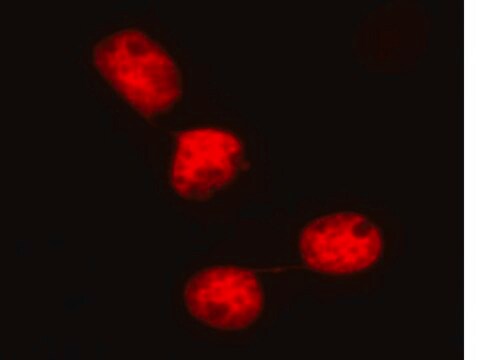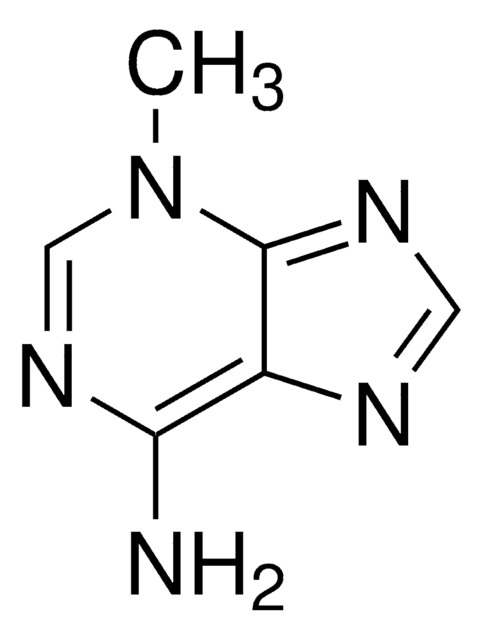17-10193
LentiBrite GFP-LC3 Lentiviral Biosensor
Synonym(e):
Microtubule-associated proteins 1A/1B light chain 3, Autophagy-related protein LC3, Autophagy-related ubiquitin-like modifier LC3, MAP1A/MAP1B light chain 3, Microtubule-associated protein 1 light chain 3
About This Item
Empfohlene Produkte
Allgemeine Beschreibung
Also available: LentiBrite RFP-p62 Lentiviral Biosensor! Click Here
Autophagy, a degradative pathway that provides recycled nutrients to cells under stress, plays both protective and deleterious roles in many diseases, including cancer, neurodegeneration, and infections. Members of the LC3 family play a key role in the maturation of the autophagosome, the central organelle of autophagy. LC3 precursors, diffusely distributed in the cytosol, are proteolytically processed to form LC3-I. Upon initiation of autophagy, the C-terminal glycine is modified by addition of a phosphatidylethanolamine to form LC3-II, which translocates rapidly to nascent autophagosomes in a punctate distribution. DNA constructs encoding fluorescent proteins fused to LC3 are widely employed for introduction into cells for monitoring autophagosome formation by fluorescence microscopy.
EMD Millipore’s LentiBrite GFP-LC3 lentiviral particles provide bright fluorescence and precise localization to enable live cell analysis of autophagy in difficult-to-transfect cell types.
Read our application note in Nature Methods!
http://www.nature.com/app_notes/nmeth/2012/121007/pdf/an8620.pdf
(Click Here!)
Learn more about the advantages of our LentiBrite Lentiviral Biosensors! Click Here
Biosensors can be used to detect the presence/absence of a particular protein as well as the subcellular location of that protein within the live state of a cell. Fluorescent tags are often desired as a means to visualize the protein of interest within a cell by either fluorescent microscopy or time-lapse video capture. Visualizing live cells without disruption allows researchers to observe cellular conditions in real time.
Lentiviral vector systems are a popular research tool used to introduce gene products into cells. Lentiviral transfection has advantages over non-viral methods such as chemical-based transfection including higher-efficiency transfection of dividing and non-dividing cells, long-term stable expression of the transgene, and low immunogenicity.
EMD Millipore is introducing LentiBrite Lentiviral Biosensors, a new suite of pre-packaged lentiviral particles encoding important and foundational proteins of autophagy, apoptosis, and cell structure for visualization under different cell/disease states in live cell and in vitro analysis.
- Pre-packaged, fluorescently-tagged with GFP & RFP
- Higher efficiency transfection as compared to traditional chemical-based and other non-viral-based transfection methods
- Ability to transfect dividing, non-dividing, and difficult-to-transfect cell types, such as primary cells or stem cells
- Non-disruptive towards cellular function
EMD Millipore’s LentiBrite GFP-LC3 lentiviral particles provide bright fluorescence and precise localization to enable live cell analysis of autophagy in difficult-to-transfect cell types.
Anwendung
Apoptose & Krebs
Neurowissenschaft
Apoptose - Weiterführende Produkte
Neurodegenerative Krankheiten
(See Figure 1 in datasheet)
HT-1080 cells were plated in a chamber slide and transduced with lentiviral particles at an MOI of 20 for 24 hours. After media replacement and 48 hours further incubation, cells were either left in complete media or incubated for 4 hours in EBSS containing a lysosome inhibitor, to induce autophagy and inhibit lysosomal degradation of autophagosomes.
Cells were fixed with formaldehyde and mounted. Images were obtained by oil immersion wide-field fluorescence microscopy. The GFP-LC3 displays a diffuse nuclear and cytosolic distribution in fed cells, and a punctate distribution in starved autophagic cells.
Immunocytochemistry Comparison and Inhibitor Analysis:
(See Figure 2 in datasheet)
Similar to Figure 1 (see datasheet), HeLa cells were plated in a chamber slide and transduced with lentiviral particles at an MOI of 20 for 24 hours. After media replacement and 48 hours further incubation, cells were either left in complete media, incubated for 4 hours in EBSS containing a lysosome inhibitor to induce autophagy and inhibit lysosomal degradation, or incubated as in, with the addition of 5 mM 3-methyladenine (3-MA) as an inhibitor of autophagy. 3-MA completely blocks formation of GFP-LC3-positive autophagic punctae. Immunocytochemical staining (red) of the same fields of view with a monoclonal antibody against LC3A reveals similar expression patterns to the GFP-protein (green), although signal is diminished following 3-MA treatment.
Hard-to-transfect Cell Types:
(See Figure 3 in datasheet)
Primary cell types HUVEC or HuMSC were plated in chamber slides and transduced with lentiviral particles at an MOI of 40 for 24 hours. Subsequent treatments for cells left in complete media or cells incubated in EBSS with lysosome inhibitor, were performed as in Figures 1A and 1B (see datasheet).
Time-lapse Imaging:
(See Figure 5 in datasheet and video online)
HT-1080 cells were treated as in Figure 1B. Shortly following initiation of starvation conditions, time-lapse imaging was performed under temperature-controlled oil immersion wide-field fluorescence microscopy, with images taken every 1 minute over the course of 2 hours. Images demonstrate the translocation of GFP-LC3 from diffuse nuclear/cytosolic localization to discrete cytoplasmic puncta.
Fluorescence Microscopy Imaging:
Cardiomyocytes were cultured on laminin-coated glass bottom dishes in standard medium and transduced with lentiviral particles at a multiplicity of infection of 50. Lentiviral particles carrying a construct of TagGFP2-LC3 driven by the elongation factor-1 promoter (Cat. # 17-10193) were applied for 24 h, the medium was changed and the pharmacological treatment was started after another 24 h. Live images were obtained by using an inverted microscope, 40× objective and a digital camera (Dimitrakis, P., et al. (2012) Cell Tissue Res. 350:361–372).
For optimal fluorescent visualization, it is recommended to analyze the target expression level within 24-48 hrs after transfection/infection for optimal live cell analysis, as fluorescent intensity may dim over time, especially in difficult-to-transfect cell lines. Infected cells may be frozen down after successful transfection/infection and thawed in culture to retain positive fluorescent expression beyond 24-48 hrs. Length and intensity of fluorescent expression varies between cell lines. Higher MOIs may be required for difficult-to-transfect cell lines.
Komponenten
One vial containing 25 µL of lentiviral particles at a minimum of 3 x 10E8 infectious units (IFU) per mL.
For lot-specific titer information, please see lot specific “Viral Titer” in the product specifications of the datasheet.
Promoter
EF-1 (Elongation Factor-1)
Multiplicty of Infection (MOI)
MOI = Ratio of # of infectious lentiviral particles (IFU) to # of cells being infected.
Typical MOI values for high transduction efficiency and signal intensity are in the range of 20-40. For this target, some cell types may require lower MOIs (e.g., HT-1080, HeLa, human mesenchymal stem cells (HuMSC)), while others may require higher MOIs (e.g., human umbilical vein endothelial cells (HUVEC), U2OS).
NOTE: MOI should be titrated and optimized by the end user for each cell type and lentiviral target to achieve desired transduction efficiency and signal intensity.
Qualität
Physikalische Form
Lagerung und Haltbarkeit
Lentivirus is stable for at least 4 months from date of receipt when stored at -80°C. After first thaw, place immediately on ice and freeze in working aliquots at -80°C. Frozen aliquots may be stored for at least 2 months. Further freeze/thaws may result in decreased virus titer and transduction efficiency.
IMPORTANT SAFETY NOTE
Replication-defective lentiviral vectors, such as the 3rd Generation vector provided in this product, are not known to cause any diseases in humans or animals. However, lentiviruses can integrate into the host cell genome and thus pose some risk of insertional mutagenesis. Material is a Risk Group 2 and should be handled under BSL2 controls. A detailed discussion of biosafety of lentiviral vectors is provided in Pauwels, K. et al. (2009). State-of-the-art lentiviral vectors for research use: Risk assessment and biosafety recommendations. Curr. Gene Ther. 9: 459-474.
Rechtliche Hinweise
Lagerklassenschlüssel
10 - Combustible liquids
WGK
WGK 2
Analysenzertifikate (COA)
Suchen Sie nach Analysenzertifikate (COA), indem Sie die Lot-/Chargennummer des Produkts eingeben. Lot- und Chargennummern sind auf dem Produktetikett hinter den Wörtern ‘Lot’ oder ‘Batch’ (Lot oder Charge) zu finden.
Besitzen Sie dieses Produkt bereits?
In der Dokumentenbibliothek finden Sie die Dokumentation zu den Produkten, die Sie kürzlich erworben haben.
Kunden haben sich ebenfalls angesehen
Artikel
HT-1080 cells were plated in a chamber slide and transduced with LentiBrite™ GFP-LC3 lentiviral particles at an MOI of 20 for 24 hours. After media replacement and 48 hours further incubation, cells were incubated for 4 hours in EBSS containing a lysosome inhibitor, to induce autophagy and inhibit lysosomal degradation of autophagosomes.
High titer lentiviral particles for LC3 variants used for live cell analysis of cellular autophagy.
Unser Team von Wissenschaftlern verfügt über Erfahrung in allen Forschungsbereichen einschließlich Life Science, Materialwissenschaften, chemischer Synthese, Chromatographie, Analytik und vielen mehr..
Setzen Sie sich mit dem technischen Dienst in Verbindung.











